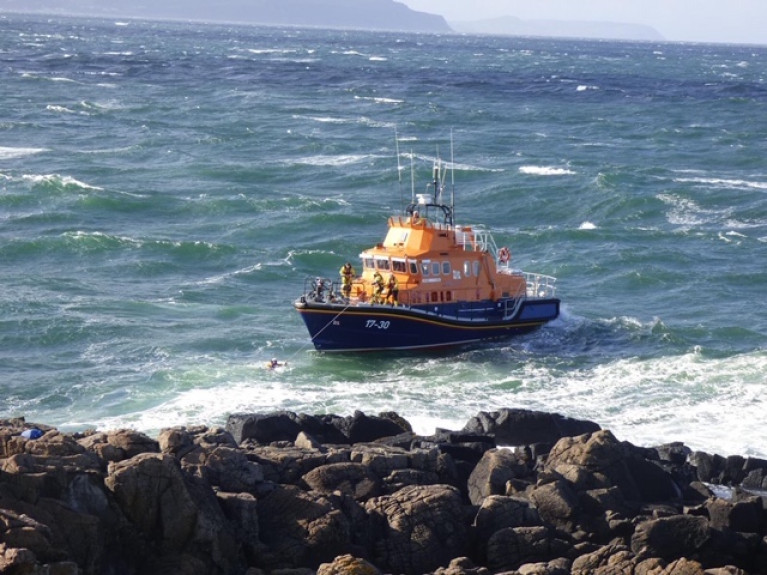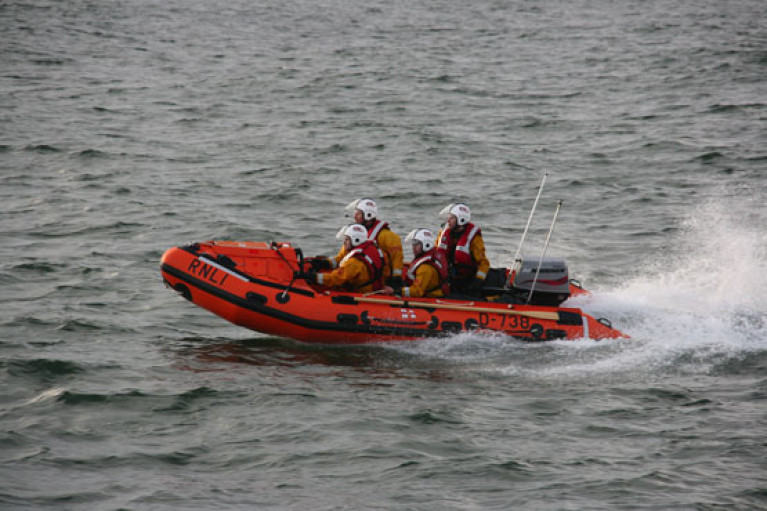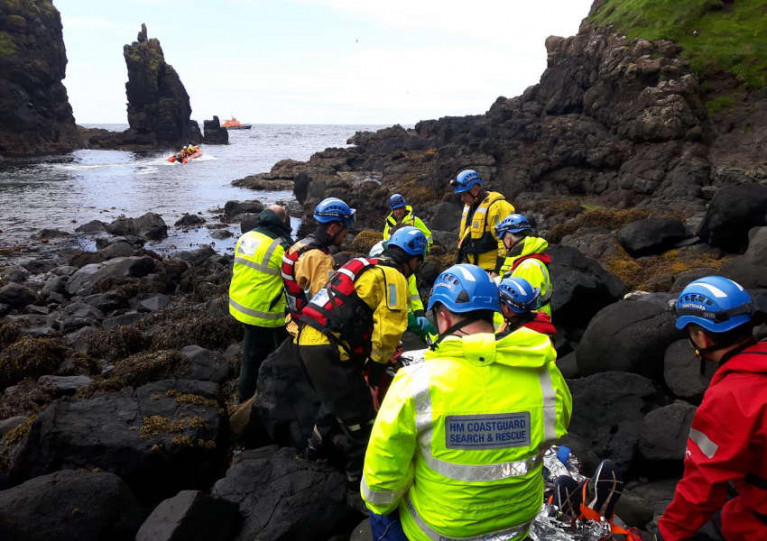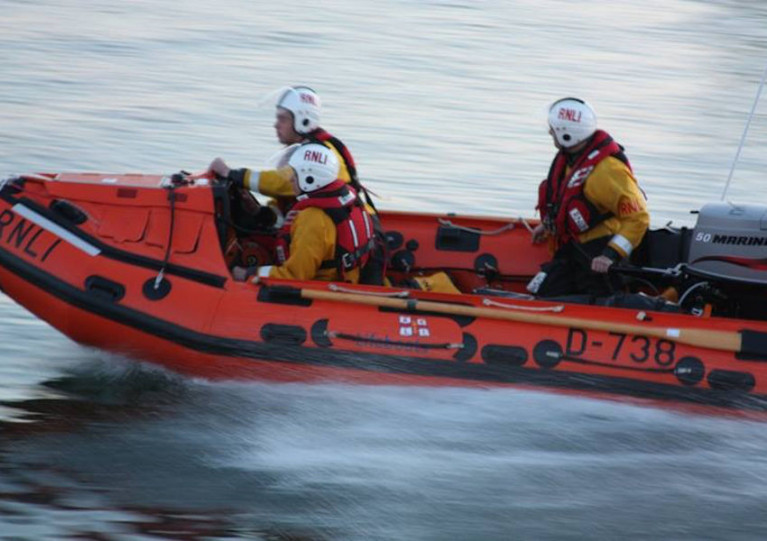Displaying items by tag: Portrush
Portrush RNLI’s volunteer crew launched their inshore lifeboat to reports of a fishing vessel in difficulty just outside the Northern Ireland harbour yesterday evening, Wednesday 31 March.
The 26-foot vessel with three on board lost power just outside the North Coast harbour’s wall at 5.25pm. Within minutes the lifeboat crew arrived in scene and set up a successful tow to the harbour pontoon.
Beni McAllister, lifeboat operations manager at Portrush RNLI, said: “With the season starting and all boats being allowed back in the harbour, we would ask that boat owners make sure that their boats are ready to go to sea and that all checks have been made.
“We are expecting a busy holiday season and look forward to welcoming our RNLI lifeguard colleagues back on the beaches this weekend.”
Double Afternoon Callout for Portrush Lifeboats on North Coast
Both Portrush RNLI lifeboats were launched within an hour of each other to separate incidents on Northern Ireland’s North Coast this afternoon (Wednesday 24 February).
Initially, the volunteer crew were requested to launch the all-weather lifeboat by Belfast Coastguard at 12.36pm in response to reports of a surfer in difficulty at Castlerock.
While en-route, the crew received notification that the surfer had made it back to the beach unaided and all was well.
When they were returning to station, they were re-tasked to reports of two persons who had been swept off the rocks just between Portrush and Portstewart.
The all-weather crew requested that the inshore lifeboat was also launched as the casualties were reported to be close to the rocks.
Conditions and visibility today were good which helped both boats to make good time.
However again, before the ILB arrived on scene, the two persons had been able to get back onto the rocks without assistance from the volunteer lifeboat crews.
Beni McAllister, lifeboat operations manager at Portrush RNLI, said: “Although both boats were launched today and were stood down on both shouts, we would ask that if people feel that there is someone in difficulty in the sea, that they dial 999 and ask for the coastguard.
“We have said this before, but our crews would rather be safe than sorry.”
Portrush Lifeboat Launches to Surfers in Difficulty at East Strand
Portrush RNLI’s volunteers rescued two surfers who got into difficulty while surfing at Co Antrim’s East Strand earlier today (Monday 1 February).
The inshore lifeboat launched before 1.30pm following a number of 999 calls to both the coastguard and the lifeboat station, and arrived on scene within four minutes amid fair weather conditions.
It emerged that the two surfers had got caught in a rip current and despite repeated attempts to get back to shore, they realised they couldn’t as they were becoming very tired. They attracted the attention of a number of onlookers who dialled 999.
Once on scene, the RNLI crew quickly recovered the two surfers into the lifeboat and returned with them to Portrush Harbour, where they were handed off to the care of the waiting coastguard team.
Beni McAllister, lifeboat operations manager at Portrush RNLI, said: “Surfing during lockdown has become extremely popular on both our beaches here in Portrush and it is a great pastime both mentally and physically.
“However, rip tides can be treacherous, and we would ask people to take care and check on conditions before entering the water.
“These two surfers did the right thing in alerting onlookers and we are relieved that people reacted very quickly and dialled 999, which allowed us to get onto scene very quickly.
“Remember if you see someone in trouble, dial 999 and ask for the coastguard.”
The crew on this callout were helm Ben Wilson and volunteers Christy Bradley and Daniel Thorne.
Car on the Edge at Portrush Harbour
A car was moments away from plunging into the sea after it edged over the side of the pier at Portrush on the North Coast on Tuesday morning at about 9.30 am.
The car moved forward from the council car parking bays facing the harbour and both front wheels tipped over the pier perimeter, leaving the vehicle sitting on its metal frame with its bonnet above the waves.
A van was used to tow the white car back onto its four wheels on solid ground and no one was injured in the incident.
Portrush is a small harbour enclosed by two piers where it is possible to berth alongside a pontoon or to pick up moorings in the harbour area.
Causeway Coast & Glens Borough Council in whose area Portrush Harbour lies, was asked for comment on the incident but it was not received at time of press
More from Belfast Live here
Portrush Lifeboat Launches To Yacht In Difficulty Off Rathlin Island
Portrush RNLI’s all-weather lifeboat launched to reports of a yacht in difficulty off Rathlin Island in Northern Ireland last night (Friday 2 October).
The volunteer crew were in the water just before 9pm, half an hour after paging, and headed to the location of the single-handed yachtsman four miles north-west of Rathlin in moderate to rough seas.
Cox Dave Robinson and his crew arrived on scene at 10pm and established that the yachtsman was able to manoeuvre himself into Rathlin Harbour, on the island off mainland Co Antrim, but requested their guidance.
“The yachtsman did the right thing in contacting the coastguard as he was experiencing some difficulties getting into harbour, and we were glad to provide the support,” said Portrush’s new lifeboat operations manager Beni McAllister.
“We would prefer that people were safe than sorry and would ask that they dial 999 and ask for the coastguard if help is required.”
Portrush RNLI Lifeboat Rescue Teenage Boy in Difficulty off Portstewart Head (Video)
Portrush RNLI has rescued a teenage boy who got into difficulty while jumping into the sea off rocks at Portstewart Head yesterday afternoon.
The volunteer crew were requested to launch their all-weather lifeboat by Belfast Coastguard at 2.42 pm following an initial request to go to the aid of someone in distress off Downhill Beach which subsequently transpired to be a false alarm with good intent. However, once on board, the lifeboat crew were alerted by the Coastguard to a separate incident after a 999 call was made by a member of the public to say a person was in difficulty in the water off Portstewart Head, some five nautical miles from Portrush.
The lifeboat launched under Coxswain Des Austin and with six crew members onboard and made its way to the scene arriving in less than 10 minutes.
Weather conditions at the time were challenging with a Force 6-7 north to northwest wind, some showers, and a rough sea with 2-3m swells. Visibility was good.
As the lifeboat approached the scene, the crew observed a person in the water waving their arms. A teenage boy who was wearing a wetsuit was struggling against an ebbing tide which was pulling him away from the land and out to sea off the west side of Portstewart Head.
The Coxswain manoeuvred the lifeboat close to where the casualty was in the surf and breaking waves while the station’s mechanic donned a dry suit and PPE. A line was then attached to the mechanic who jumped into the water and grabbed the casualty to safety. The remainder of the crew pulled the mechanic and casualty around to the starboard side of the lifeboat as the Coxswain manoeuvred into position.
 A line was then attached to the lifeboat mechanic who jumped into the water and grabbed the casualty to safety
A line was then attached to the lifeboat mechanic who jumped into the water and grabbed the casualty to safety
The lifeboat crew administered casualty care to make the boy who was showing signs of hypothermia and exhaustion and was suffering from the effects of shock, comfortable, as the lifeboat made its way back to Portrush Harbour. He was then transferred into the care of Coleraine Coastguard and the Northern Ireland Ambulance Service.
Speaking following the call out, Portrush RNLI Coxswain Des Austin said: ‘Conditions were challenging at sea today and time was of the essence. The tide was turning at the time the casualty got into difficulty and the conditions were pulling him out to sea.
The prompt actions of the lifeboat crew saved a life and we would like to wish the casualty well following his ordeal.
‘We would remind anyone planning an activity at sea to always respect the water. Always be prepared, always have the right clothing and safety equipment including a lifejacket or buoyancy aid. Conditions at sea can change quickly and it is important to understand how that affects the area of coastline.
Should you get into difficulty or see someone in trouble, dial 999 or 112 and ask for the Coastguard.’
Rescue For Family Cut Off By Rising Tide In Portrush
Portrush RNLI’s volunteers launched to the aid of a family cut off by the rising tide on cliffs yesterday evening, Saturday 22 August.
Local lifeguards raised the alarm for the two adults and three young children who were trapped between Castlerock and Downhill beaches on Northern Ireland’s North Coast, and the inshore lifeboat set off to their rescue just after 5pm.
The lifeboat crew found the family some 10 feet up a cliff, close to the railway line — prompting the decision to evacuate them carefully down the cliff to shore.
Forming a human chain, the RNLI crew and a lifeguard were able to take all five family members down to the lifeboat and then onwards to the safety of the beach.
Commenting after the callout, lifeboat operations manager Keith Gilmore said: “This has been a very busy summer for both our volunteer lifeboat crew and the lifeguards on all our beaches in the area, and this is another example how we have worked very closely together to carry out a successful rescue.
“Of course, we have had the additional issue of having to wear PPE for the protection of the public and the crew, but it is something we are becoming used to wearing.
“The RNLI lifeguards and our crew worked well today in this joint rescue and the hope the family are recovering from their ordeal.”
Portrush RNLI’s all-weather lifeboat launched late yesterday afternoon (Sunday 16 August) to reports of two missing divers just off Rathlin Island.
The divers were part of an organised party with a diving school, and the dive leader immediately raised the alarm with the coastguard as a precaution.
But as the lifeboat headed to Rathlin, the crew were informed that the divers had been found and recovered by the dive boat.
Portrush RNLI was asked to standby at Ballycastle in case a medical evacuation was required.
However, the dive company had a doctor on board, and the divers were assessed as being fit and handed over to the NI Ambulance Service to be taken to hospital as a precaution.
Lifeboat press officer Judy Nelson said: “This has been one of our busiest seasons as people are choosing to holiday at home and try sea-based activities that they may not have done before.
“We would advise the public to book these activities with an experienced group, who on this occasion observed all safety precautions and raised the alarm immediately, thus preventing an untoward event.”
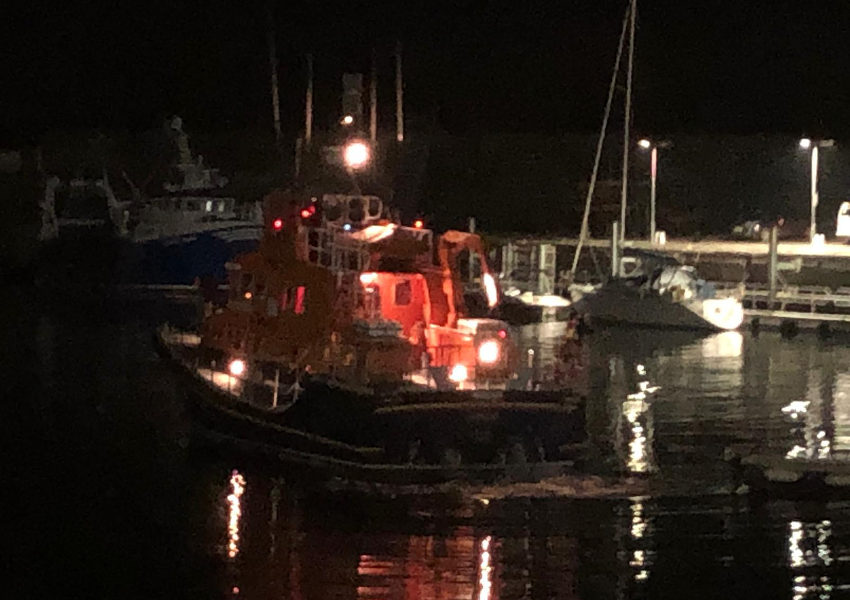 Portrush RNLI’s all-weather lifeboat launches to reports of a flare | RNLI/Ben Durrant
Portrush RNLI’s all-weather lifeboat launches to reports of a flare | RNLI/Ben Durrant
Portrush RNLI previously launched the all-weather lifeboat just before 1am on Sunday morning to several reports of a distress flare in the Portstewart Strand area.
After a thorough search of the vicinity with nothing found, the multi-agency response — including the PSNI and HM Coastguard — was stood down and the lifeboat returned to station by 3.30am.
This was also Portrush RNLI crew member Dave Robinson’s first shout as coxswain since passing RNLI assessments two weeks ago.
Deputy launching authority Carl Kennedy said: “As the RNLI will always respond to reports of a distress flare being spotted, we would ask members of the public to take care when launching any kind of light, firework, flare or Chinese lantern during the night as these can be seen as distress flares and reported as an emergency call.
“This can entail, as it did tonight, huge resources being deployed by emergency services to ensure that there was no-one in danger.
“Tonight this was a false alarm with good intent with no one in danger.”
Elderly Man Rescued After Fall In Cave Near Giant’s Causeway
Coastguard units from Coleraine and Ballycastle were tasked to rescue a man in his 70s who had fallen in a cave close to the Giant’s Causeway on Friday (7 August).
The casualty had sustained a knee injury and was being treated at the scene in Smuggler’s Cove on Northern Ireland’s North Coast by NIAS paramedics.
Due to the remote location, the decision was made to evacuate the injured man by RNLI lifeboats from Portrush.
The challenging terrain made extraction difficult and complex.
First the man was moved by rope rescue stretcher over very uneven and slippery boulders to the water’s edge, then transferred into coastguard water rescue stretcher, then onto the inshore lifeboat.
From there to the all-weather lifeboat for transfer to a waiting ambulance at Portrush Harbour.
Coleraine Coastguard said: “This was a highly challenging rescue due to the location, but another great example of inter-agency teamwork brought it to a successful ending.”
Portrush RNLI’s inshore lifeboat launched to the rescue of a 50-year-old woman who fell into the water while with a coasteering group at Dunseverick near the Giant’s Causeway in Northern Ireland yesterday afternoon (Saturday 1 August).
The volunteer crew applied casualty care to the woman, and one remained to watch over her while the lifeboat collected a paramedic and a member of the local coastguard team to assist at the scene.
Suspecting the woman had sustained a back injury, the team called for a helicopter and she was transferred to the Royal Victoria Hospital in Belfast by the regional air ambulance. R199 from Prestwick in Scotland was also dispatched to the scene.
Portrush lifeboat operations manager Keith Gilmore said later: “Causeway Coasteering did exactly the right thing in calling the RNLI and the coastguard to make sure that the casualty could receive appropriate treatment.”































